|
Order:
Lamiales
Life
> eukaryotes >
Archaeoplastida >
Chloroplastida
>
Charophyta > Streptophytina > Plantae (land plants)
> Tracheophyta (vascular plants) > Euphyllophyta > Lignophyta (woody plants)
> Spermatophyta (seed plants) > Angiospermae (flowering
plants)
> Eudicotyledons > Core Eudicots > Asterids
> Euasterid I
There are 24 families of which
17 occur in southern Africa. Worldwide, there are 1059 genera
and 23810 species, of which 205 genera and 1976 species are native
to southern Africa, 22 genera and 65 species are naturalised and 126 genera and 432 species are cultivated in the region.
The Lamiales is defined
mainly on the basis of genetic and biochemical information. Flowers of most
species have only one plane of symmetry (ie. monosymmetric) and plants are
usually herbaceous. Evidence suggests that this order evolved about 97 to 74
million years ago. (Angiosperm Phylogeny Website,
Version 12).
Families encountered in southern Africa
Note: Buddlejaceae and Myoporaceae have been synonymised
with Scrophulariaceae.
|
Acanthaceae (Black-eyed Susan family)
There are about 350 genera and 4350 species
worldwide (mainly in the tropics and subtropics), with 49
genera and 424 species in southern Africa, one genus and species is
naturalised, and a further 15 genera
and 55 species cultivated in the region. |
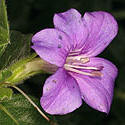
|
|
Bignoniaceae (jacaranda family)
Worldwide, there are about 750 species and 109 genera in
the family Bignoniaceae, with 10 genera and 16 species native to southern
Africa, three genera and four species naturalised and an additional 25 genera and
60 species cultivated in the region. |

|
|
Calceolariaceae
Two genera and 260 species (South and Central America, New
Zealand). About three species in the genus Calceolaria are cultivated
in southern Africa. Members of this family were previously included under
the Scrophulariaceae. |
|
|
Gesneriaceae (African violet family)
About 147 genera and 3200 species, found patchily worldwide but mainly in
the Old World (especially China). One genus and 63 species are native to
southern Africa (Streptocarpus),
with an additional 12 genera and 22 species cultivated in the region. |
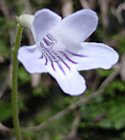 |
|
Lamiaceae - Labiatae (mint, lavender, basil family)
This is a large family of about 252 genera and 6700
species worldwide, with 39 genera and 350 species native to southern Africa,
five genera and 16 species naturalised and 38 genera and 141 species cultivated
in the region. There are many culinary and medicinal herbs in this family. |
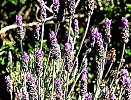
|
|
Lentibulariaceae
Carnivorous plants, found in wet places. There
are three genera and about 245 species (cosmopolitan), with two
genera and 21 species native to southern Africa. |
|
|
Linderniaceae
There are 13 genera and 195 species (pantropical to warm
temperate, mainly New World), of which two genera and 13 species are
native to southern Africa. These genera were previously placed in the
Scrophulariaceae. |
|
|
Martyniaceae Five genera and 16 species (New World); two
species of different genera (Ibicella
and Proboscidea) are naturalised in southern Africa. |
|
|
Oleaceae (olive family)
There are 24 genera and 615 species worldwide (cosmopolitan
but mainly East Asia), with five genera and 25 species native to southern Africa. There are an additional nine exotic genera and
50 species cultivated in
southern Africa. |
 |
|
Orobanchaceae
There are 99 genera and 2061 species (nearly worldwide), with
15 genera and 113 species native to southern Africa. There is an additional
one genus and two species naturalised, and an additional two genera and two species cultivated in
southern Africa. Members of the Orobanchaceae were previously included under the
Scrophulariaceae. |
|
|
Paulowniaceae
Contains a single genus, Paulownia, with six
species, native to East Asia, especially China. One species, Paulownia
tomentosa (Empress tree) is cultivated in southern Africa. Paulownia
was previously placed in the
Scrophulariaceae. |
|
|
Pedaliaceae (sesame family)
There are about 13 genera and 70 species worldwide (mainly
tropics and subtropics) of which eight genera and 32 species are native to
southern Africa, mainly in semi-arid regions. An additional two species are
cultivated in the region. |
|
|
Phrymaceae
About 19 genera and 234 species (worldwide), with one genus (Mimulus)
and one species native to southern Africa, another species naturalised and
an additional five species that are cultivated in the region. |
|
|
Plantaginaceae (plantains)
The Plantaginaceae used to be a relatively small
family of about three genera and 255 species but recent studies have
moved a large number of genera from the Scrophulariaceae into this
family. It therefore now has about 90 genera and 1700 species, of
which seven genera and 29 species are native to southern Africa
and five genera and 24 species are naturalised. There are also an additional
15 genera and 53 species cultivated in the region. |
|
|
Scrophulariaceae (snapdragon, foxglove family)
There are about 65 genera and 1700 species (cosmopolitan) of
which 47 genera and 825 species are native to southern Africa. There are also
an additional two genera and three species naturalised and an additional three
genera and 23 species cultivated in this region. From recent work on this family
and related families, a large number of genera have been moved to other families
in the Lamiales (mainly Plantaginaceae,
Orobanchaceae and to a lesser extent
Stilbaceae). |
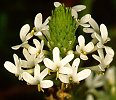
|
|
Stilbaceae
There are 12 genera and 27 species, mainly
occurring in the fynbos of the Western Cape in South Africa but with
some representatives distributed through Africa, Madagascar, the
Mascarene Islands and southern Arabia. From recent molecular
studies, the genera Halleria, Charadrophila, Bowkeria, Anastrabe
and Ixianthes have been moved to this family from the
Scrophulariaceae and Nuxia has been moved from Loganiaceae to
Buddlejaceae to its present home in the Stilbaceae. |
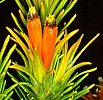
|
|
Verbenaceae (teak, lantana family)
There are a total of 34 genera and 1175 species (worldwide),
of which seven genera and 37 species native to southern Africa. An additional
three genera and 12 species have become naturalised in the region, and
an additional two genera and 14 species are cultivated in southern Africa.
A number of genera have been moved from the Verbenaceae to the
Lamiaceae. |
 |
Families not encountered in southern Africa:
Byblidaceae, Carlemanniaceae, Mazaceae,
Plocospermataceae, Schlegeliaceae, Tetrachondraceae, Thomandersiaceae |
